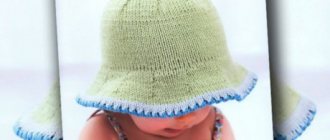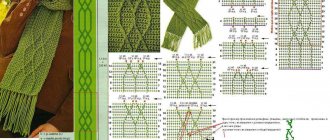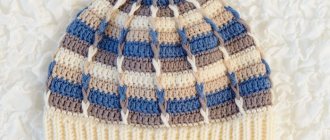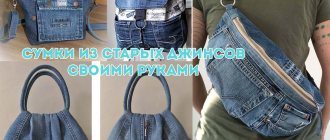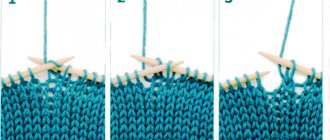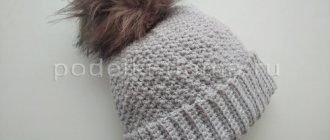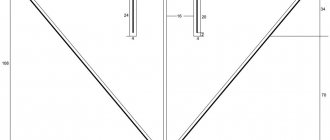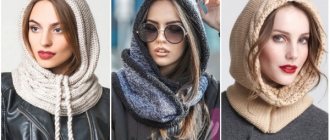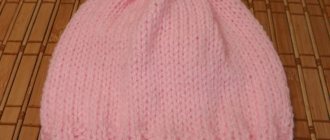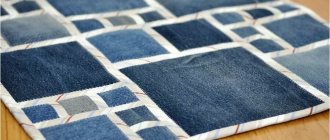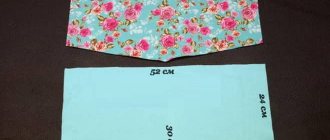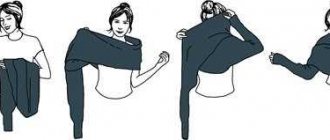Openwork shawls, scarves on the head and shoulders look incredibly feminine. Crocheted scarves look especially stylish and beautiful due to the ability of the knitted fabric to be airy and lacy. There are many patterns and patterns that are easy to make even for beginner knitters. And if an experienced craftswoman gets down to business, the result of the work will exceed all expectations. Therefore, the given descriptions of crochet scarves with diagrams and descriptions will be useful both to beginners in knitting and to craftsmen with a wealth of knowledge.
Abbreviations for knitting patterns
For convenience and better understanding, the following designations are used in the description of the work:
- air loop - AirLoop. (or V.P.);
- double crochet - StolbSNak. (or SSN.);
- single crochet - Column. b/Nak;
- column - Column. (or with.);
- chain - CHAIN;
- loop - P.;
- yarn over (loop thrown over a knitting needle) - NAC;
- *…* — the pattern between the stars is repeated.
These designations are used for each of the presented circuits.
What will you need at work?
Various yarns can be used to knit a scarf. It is selected taking into account the model of the future product. For example, to make summer options, it is recommended to use thin threads, which allow you to knit extraordinary patterns. Preference is given to natural-based materials. For example, cotton would be an excellent solution in this case.
A crocheted openwork scarf will look even more original if you decorate it with various decorative elements. For example, you can use sequins, rhinestones or beads to create decor. In this case, the accessory will become a real work of art.
To create a warm crochet scarf, it is recommended to use woolen threads. The best yarn is one that contains acrylic, but in a minimal amount. Thanks to this, the accessory will be more durable and durable. If there are too many synthetic fibers, the hair will be magnetized. Naturally, this causes discomfort. In addition, the hairstyle may be ruined.
The tool is selected taking into account two nuances. It is extremely important that it matches the chosen yarn. Information about the required tool is indicated on the label with the skein. Its number is selected taking into account the thickness of the thread. In addition, the hook should be convenient for the craftswoman herself. It is unacceptable for discomfort to arise while working with it.
If the product is large, complex patterns are selected, the choice should be made on tools equipped with a large handle. When using them, the risk of hand fatigue is minimized. Beginning craftswomen should take a closer look at options where the central part of the handle is flattened. Using them makes it much easier to master knitting techniques. True, initially it is better to choose basic patterns, increasing the level of complexity gradually.
Openwork scarf
The scarf was previously used at the end of the 18th century to cover the neckline of the karako (a jacket with long tails and semi-long sleeves).
To knit such a scarf (shawl), you need to select about 300-400 g of thread in pastel shades No. 32/2 in 4 layers. The shawl pattern is a combination of two types of rhombuses, in one of which flowers are knitted, and in the other a mesh is knitted. The shawl is knitted from the bottom end, while the knitting evenly expands on both sides .
- 1st row: a chain of 3 chains, then a bunch of 2 columns is knitted. in 1st P. chain, 3rd Loop. and a combination of 3 StolbSNak. in the 1st P. of the original chain (see center of the diagram).
- 2nd row: 3 Air Loop. for upward growth, a bundle of 2 StolbSNak. (the hook must be inserted under the top of the previous combination Column.), 4 V.P., Column. b/NAK. under a chain of 3 V.P. of the previous row, 4 AirLoop, combination of 3 ColumnSNak.
- 3rd row: Three Air Loops. to increase upwards, a combination of 2 ColumnsSNak. in a bundle Column. from the previous row, 4 VozdPetl., S. b/Nak. for a chain of 4 air loops, CHAIN. of 5 air P., table without loop, CHAIN. from 4 AirLoop. and a combination of 3 StolbSNak. into a combination of columns of the bottom row.
- The 4th, 5th and subsequent rows are knitted according to the pattern, while the shawl fabric expands evenly. Work on all rows is completed with a combination of 3 ColumnsSNak.
Then you need to knit diamonds in two rows, in which the flower is in the center, and the diamonds with the mesh and the flower alternate with each other. At the end of the work, the product is tied along the upper edge .
- 1st row: 3 chain stitches, S. without a chain stitch thrown over each chain of five chain stitches of the previous row.
- 2nd row: * Column SNak., 1 Air Loop. and so on from the asterisk to the end of the row (Column SNak. Use in turn for this either S. single crochet of the previous row, or a chain of 3 chain loops). Then they continue tying, without tearing off the thread, on the sides (those that are short) of the shawl like this: * a column with a stitch draped under each link of the rhombus, 3 air loops. and so on from * to the end of the row. Next, you need to tie the work along the upper edge in the opposite direction with columns without a loop thrown over it (the hook should be inserted under all the chain loops of the previous row).
When the shawl is ready, it must be carefully ironed, trying not to crush the flowers from the wide columns; To decorate the shawl, fold tassels of thread into 16 - 20 layers, tie them along the edge of the work and intertwine them together at the same level. This shawl can be worn both on the shoulders, in the form of a cape, and as a scarf around the neck. A hook, a diagram and a description, not counting the threads, is all that is needed to complete this work, since it is not at all difficult, and even beginners will enjoy the result.
Video: Crochet “scales” pattern
Fishes.
A bright fish can be used not only to decorate a women’s beach scarf, but also to decorate a girl’s scarf:
A white fish made using the Irish technique is more suitable for decorating a woman’s beach scarf:
Tunisian.
The main distinguishing feature of Tunisian technology is density. Products knitted using the Tunisian method are very warm.
To create any Tunisian pattern, a special long hook is required. In this technique, products are knitted back and forth.
The first row consists of an air chain. Then the loops are knitted from right to left:
Sirloin or complicated Spiders.
The standard fillet pattern can be slightly complicated. To do this, you just need to supplement it with the same Spiders as in the picture:
The product is formed from the base to the corner. First, a chain is made that is a multiple of 23, plus another 5 vp. for lifting.
In order not to go astray, you must first follow the diagram very carefully! The pattern in it is formed from the first row. But, after 2-3 rows the knitting principle will become clear, and the craftswoman will be able to “immerse” herself in the creative process without looking at the pattern.
Snow-white shawl
Shawl - a strip of rectangular fabric that came from eastern countries, which served to cover the upper body from the cold. In the 15th century, in the Indian region of Kashmir, shawls were made from the fine wool of Tibetan goats. Authentic shawls were distributed throughout Europe during the Directory. They were an addition to suits that imitated the antique version - gathered clothes, which lacked sleeves and had a deep neckline. Precious cashmere shawls quickly began to be replaced by more affordable fake options.
Scarf and gloves
At the beginning of the history of their appearance, gloves not only protected, but also decorated hands. Examples of these clothing items were discovered in the pyramids of Egypt during the 21st Dynasty. Initially, gloves looked like bags with no openings for fingers, and much later a product similar to a mitten appeared.
In the Middle Ages, they used gloves that had no compartments for the fingers, and they were similar to today's mittens. A leather version with a cloth lining, or gloves made of metal rings, were part of the equipment of warriors and hunters. For the highest rank, this type of clothing was encrusted with jewelry.
For the finished product you need to take 200 g of light-colored yarn No. 32/2 in 3 folds. To do the work, take a hook size No. 3. The scarf will be about 22-26 cm wide, its length will be 140-150 cm.
The product should be started from the center, i.e., connected with a CHAIN. from 50 AirLoop. and then carry out the presented pattern (the result of completing the product will be three “fan” patterns in width) first in the first direction, and then from the center of the work in the second direction. Finish the work on the two halves of the scarf with the second row of the pattern according to the diagram.
Next, the finished product should be tied in three rows in a circle, continue to knit “fans” along the edges of the scarf, while the hook is inserted on the first side of the work under a chain of seven Loops, on the second side under the Pillar. with 2 yarn overs. In the third row of processing, the teeth are made of 3 VozdLoops. make a “fan” along the entire “fan” of the previous row (each “fan” will have 9 teeth).
Alternatively, gloves can be knitted on 4 knitting needles of the second size with an additional fifth to complete the work in a way that everyone knows as knitting sock fabric. The gloves will be decorated with four openwork stripes of 3 front stitches each against the backdrop of purl stitches throughout the glove. To make an openwork pattern, knit every 4th row in the following way: NAC., three loops together, NAC.
MK: how to knit a white scarf for a young lady
Such a thing, due to its modest pattern, will look great on the head not only of a child, but also of a young lady. Since the laconic look is good for a teenage wardrobe, while a girl’s scarf can be decorated with additional elements: sequins, flowers, ribbons or brooches.
Materials
You will need white polyacrylic yarn - 50g (145m) and a hook No. 3.5.
Black shawl with colored stripes
At the end of the 40s. In the 19th century, an accessory such as a scarf was incredibly fashionable, but only in a single-color version, as an addition to the checkered crinoline, which was very popular.
Material: 200 g wool yarn No. 32/2. Hook No. 2.5 or No. 3.
The pattern is presented in the diagram, but the principle of its implementation is simple: 3 ColumnsSNak. form a combination, between them there is a chain of 3 Air Loops.
So, the beginning of knitting is the middle of the wide side of the work. The dimensions of the product can be different, as you need. Increases are made only in two places - on two sides of the center line emanating from the beginning of knitting.
- 1st row: knit a chain of 3 Asc., then perform 2 Stolbs. on the first P. of this chain. Knit another chain of 3 Air Loops. and 3 SSN. on the same original P. TsEP., on which 2 ColumnsSNak are already connected.
- 2nd row: chain of four Air-Loops, two Columns. in the first P. CEP. air loops, chain. from 3 AirLoop. further above the CEP. of the last row, two groups of 3 St. SN are knitted, separated by a CH, from 3 Ch. - in this way, additions are made, this action is repeated further in this place in each next row. Next, perform CEP. from 3 AirLoop. and 3 SSN. on the last P. of the last row.
As you can see, this knitting is not difficult. Between the colorful stripes there are 3 rows, connected with black threads. The colors of the stripes can be selected in different colors as desired.
The finished shawl must be tied with 2 rows of StolbSNak., and another option is a small border. The pattern of this border is shown in the diagram. At the end of the work, brushes are tied, the length of which will be 12-18 cm.
Yarn selection
The yarn model depends on the product itself (size and thread). Iris yarn is perfect for a light summer scarf. This is a thin thread from which the craftsman usually makes elegant napkins. Contains pure cotton thread.
A summer scarf for a girl instead of a Panama hat is a creative solution for parents. You can also use thicker cotton. A thread with different inclusions, for example, sequins or different thread thicknesses, looks unusual.
But warm scarves can be made from wool yarn. It is very important that the yarn does not contain acrylic, as it magnetizes the hair and wearing such a product will not be very pleasant, plus the hairstyle will deteriorate. But a small amount of it cannot interfere, so a small percentage can be included in the composition of the selected fabric.
Openwork mohair shawl
Mohair is a fabric that was obtained by processing the wool of the Angora goat, long and thin, with a silky sheen. Mohair was brought to Europe from Asia Minor.
To get a beautiful and openwork shawl, you should take thin peach mohair (another pastel color) - 100 g (in one thread), and 35 g of dark beige or other opposite shade of thread No. 10/2 (in one thread) for knitting the trim. Hook size no. 3.
Knitting: the main pattern is given with the shawl pattern: CHAIN. of 5 Air Loops, secured by two posts without a loop thrown over, between which three Air Loops are connected. (pico). The hem is made with teeth - the knitting pattern is shown in the diagram.
The shawl is knitted starting with the VozdLoop chain. the length of which is 160−170 cm (according to the diagram). Then you should knit on the chain. through one P. ColumnSNak., and between them along the 1st Air Loop. (see row 1 of the diagram of the main pattern) - this way a “lattice” pattern is obtained. All further rows are knitted with the main pattern, but there is no need to knit 5 Ch.Loops at the end of each row until one chain of 5 Ch.Loops remains.
After this, you need to tie the shawl on both sides with a “lattice”, and on it tie a border of 3 rows of the main pattern, ending it with the same “lattice”. After this, you need to tie the border with cloves with brown thread (see diagram). The finished teeth should be tied with b/NAK posts. pink thread.
To decorate the lower corner of the shawl, ruffles are made, which should be knitted from pink threads; and the cells that formed the main pattern must be tied on 3 sides (the diagram shows the direction of processing). All parties end as follows:
- 1 ColumnSNak.;
- 1 Column. with two NACs;
- 3 AirLoop;
- 1 Column. with two NACs;
- 1 ColumnSNak.
Tie the completed ruffle with a contrasting thread in one row using a single stitch.
Elegant summer scarf with daisies for a fashionista girl
A summer children's scarf consists of motifs: daisies and petals. Flowers and leaves are knitted according to the pattern:
A short tutorial on flower formation:
A short description of the leaf:
The finished elements must be steamed. Then they need to be sewn with monofilament or regular white thread. Since the product is knitted for a child, it is best to use 100% cotton threads.
It is not always convenient for kids to wear scarves with ties, so you can make an unusual model with an elastic band:
And to make delicate crocheted scarves for girls look more impressive, you can decorate them with flowers:
Openwork shawl scarf for shoulders
Most often, such products are knitted from the corner, and this shawl is no exception. First, the CHAIN is knitted. from fourteen P., then knit rows of the pattern.
- 1st r. - 4 ColumnSNak. on 4 P. CHAIN., starting from the ninth P. from the hook, 4 Asc., 1 St. with 2 NAC. on the same P. TsEP. the product is turned at the end of all rows.
- 2nd r. - 8 air P., four Column. with a double crochet under a chain of 4 P., 2 V.P., 4 StolbSNak. under a chain of 8 P., 4 Air Loop., 1 Column. with 2 loops thrown under the same CHAIN.
- 3rd r. - 8 V.P., four StolbSNak. in the 1st chain, 3 V.P., 1 ColumnSNak. in the 2nd chain, 3 V.P., 4 ColumnSNak. in the third chain., 4 V.P., 1 Column. with two loops thrown under the same chain.
- 4th r. - 8 V.P., 4 ColumnSNak. in the first chain, 4 Air Loop., 2 S. b/Nak. under the 2nd chain, 1 Column. single crochet on ColumnSNak., 2 Columns. single crochet under the third chain, 4 air loop, 4 columns, 4 v. p., 1 column. with 2 yarn overs under the fourth chain.
- 5th r. - 8 V.P., 4 ColumnSNak. in the 1st chain, 4 V.P., 2 S. b/NAK. under the second chain, 5 S. b/NAK. on the base columns, 2 Columns. without crochet under the 3rd chain, 4 Ch., 4 Dc., 4 Ch. and 1 Column. with 2 yarn overs under the fourth chain.
- 6th r. - 8 AirLoop, 4 ColumnSnak. in the first chain, 2 V.P., 4 ColumnSNak. under the second CHAIN., 4 V.P., 5 Column. without NAC. at 5 Column. base, 4 V.P., 4 ColumnSNak. under the third CHAIN., 2 air loops, 4 ColumnSNak., 4 V.P. and 1 Column. with 2 NAC. under the 4th chain.
- 7th r. - 8 Air Loop, 4 SSN. under the first CHAIN., 3 V.P., 1 ColumnSNak. under a chain of 2 loops, 3 V.P., 4 StolbSNak. under the CEP. from 4 P., 3 V.P., 1 ColumnSNak. on the middle Pillar. without NAK., 3 Air Loop., 4 Column SNak. under a chain of 4 P., 3 V.P., 1 column with NAC. under a chain of two P., 3 VozdLoop., 4 ColumnSNak., 4 V.P., 1 column with 2 NAC. under the remaining chain.
Crochet bright cotton headscarf for girls
Greetings! I crocheted a cotton scarf. It turned out bright, plump, just right for summer for a girl of three or four years old. Contacted easily and quickly! For those who prefer to knit not according to the pattern, I have prepared a detailed description.
I knitted a scarf according to this pattern found on the Internet. In general, you can find a lot of similar schemes. I liked the pattern in this one, so I settled on it.
The scarf is crocheted No. 2.5. The yarn is different - in composition and color:
- pink (plain) and white-green (printed, “green melange”) - “Coco” Vita, 240m/50g, 100% mercerized cotton, single thread;
- yellow “Assol” Nazar, 500m/50g, 100% cotton, two threads.
The scarf is easy to knit
Additionally, I showed the directions in each row on the diagram with multi-colored arrows.
1p (blue arrows): Cast on a chain of 7 air loops, then make 1dc in the 1st loop. 3 ch from it, and another double crochet in the first stitch.
You see, two “arches” of three “airs” have appeared to the left and right of the central double crochet.
2p (pink arrows): the scarf unfolds, cast on 3 chain stitches, knit 7 dc in the first “arch”, 1 dc in the central dc, 7 dc in the second “arch”, 1 dc in the fourth loop before. R.
3p (green): We turn around again, cast 6 VP, three of which are lifting loops, 3 for the “arch”, immediately dc into the jumper between 1-2 columns, 1 VP, missed two loops, in the next three 3 dc, 1 VP , 1СН in the jumper next to the central one. loop, 3 VP, 1 StSN in central. Dc, then repeat until the end of the row “mirror”, ending with a double stitch. in the 1st paragraph before. R.
4p (yellow): 3VP, 7DC in the 1st “arch”, 1VP, skip 2 p., 3DC, 1VP, 1st CH, 3VP, central. St SN, repeat until cr.
5p (red): 6VP, St DC in the jumper, skip 2 stitches, 3DC, VP, double DC with three air stitches (i.e. first 1DC DC was knitted into the same loop, made 3 VP, then the second one there too StСН), VP, missed 2 p., 3СН, VP, St СН in the jumper in front of the center. loop, dc in center. loop, continue in the same way until the end of the r.
And then the 4th and 5th rows are constantly repeated as many times as you need for the desired size of scarf.
I have a scarf measuring 52x25cm. Laces 26 cm long.
I started with pink yarn, then alternated yellow and lime-white threads (4 and 2 pp, respectively). Finished with two rows of pink ones.
I tied the laces in this way: without tearing off the thread, I cast on 60 stitches.
I went over them with RLS and continued along the edge of the scarf (I got 110 stitches). Having reached its opposite edge, I again made a chain of 60 stitches. I walked in single crochets completely along the entire long row twice.
So that the laces have a slightly pointed appearance at the ends, in these two rows the last three loops are knitted in half-stitches (single crochets).
This is how we made a cotton summer scarf for our great-niece. I think that you can also knit a flower-petal like this to decorate your scarf. Just here you need something light and airy))
I also took one photo on a mannequin to at least roughly show how it looks on the head.
I hope you liked the scarf. And now you, too, can easily knit such a headdress for your baby.
Have fun knitting!
Best regards, Saule Vagapova
